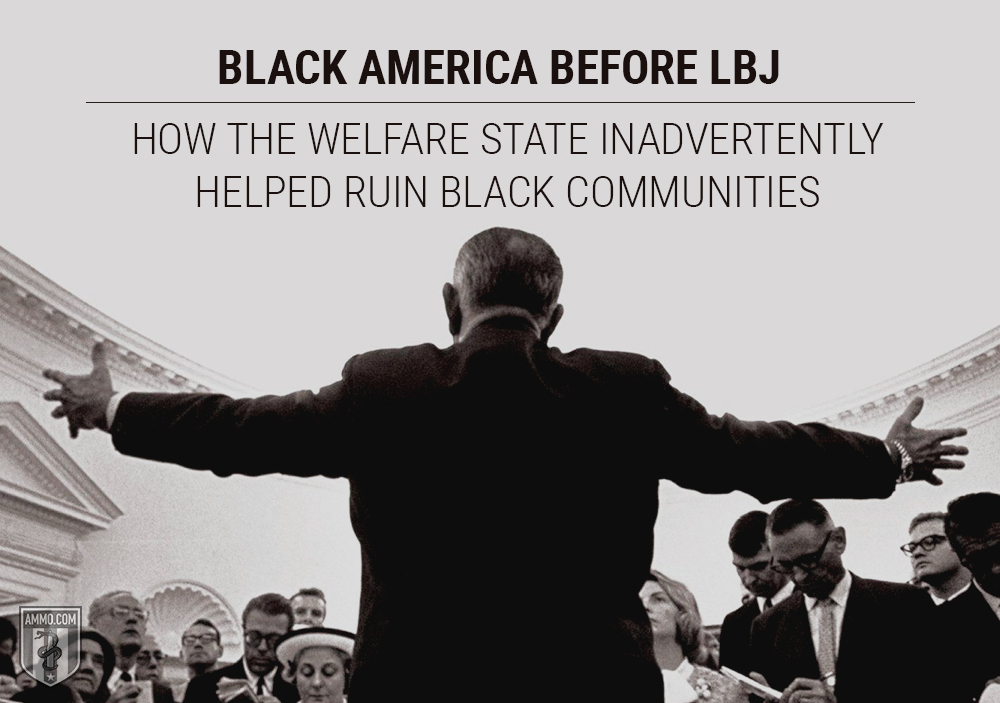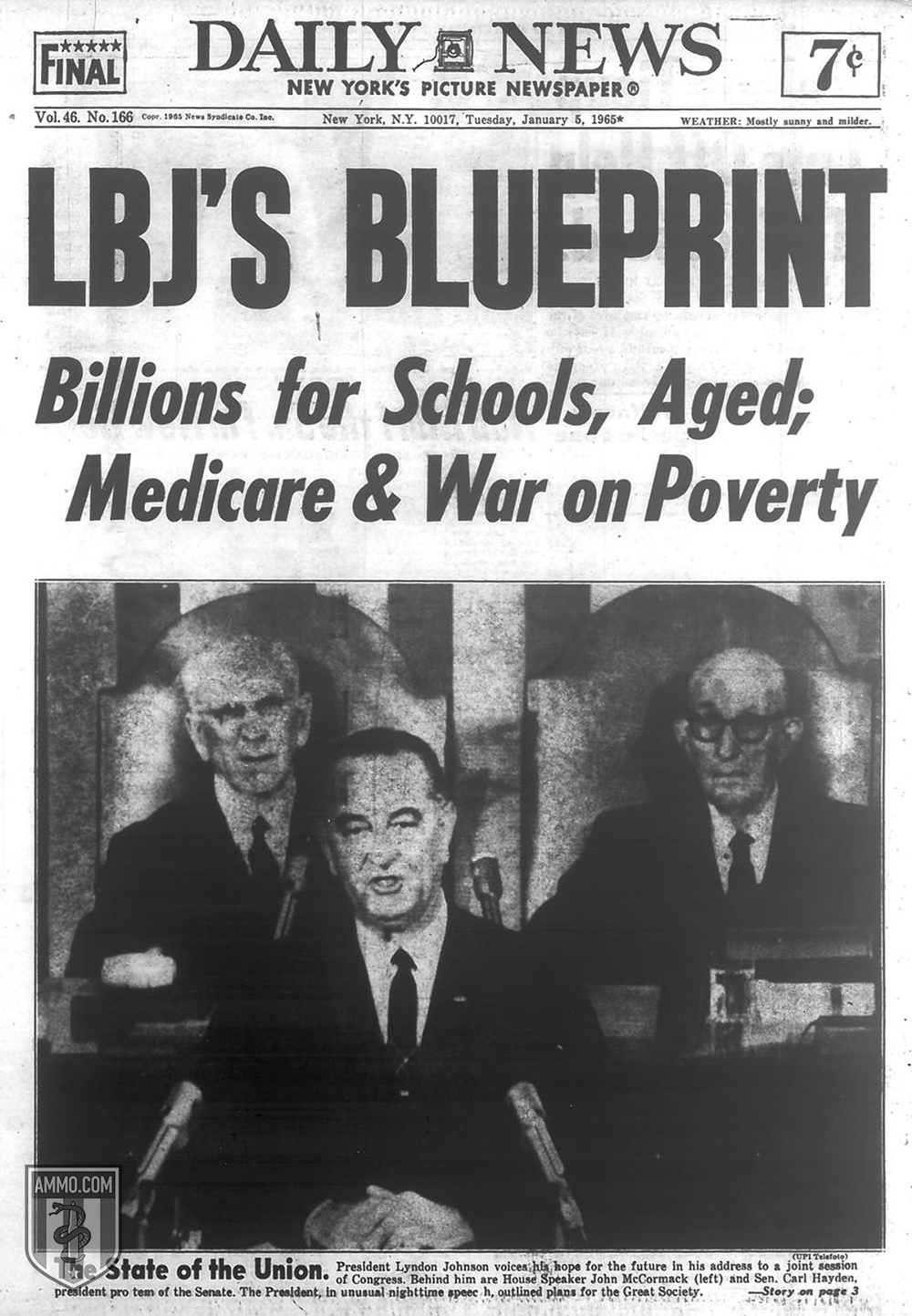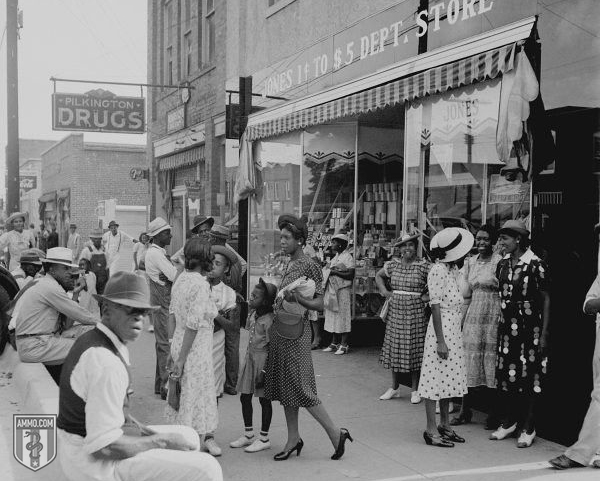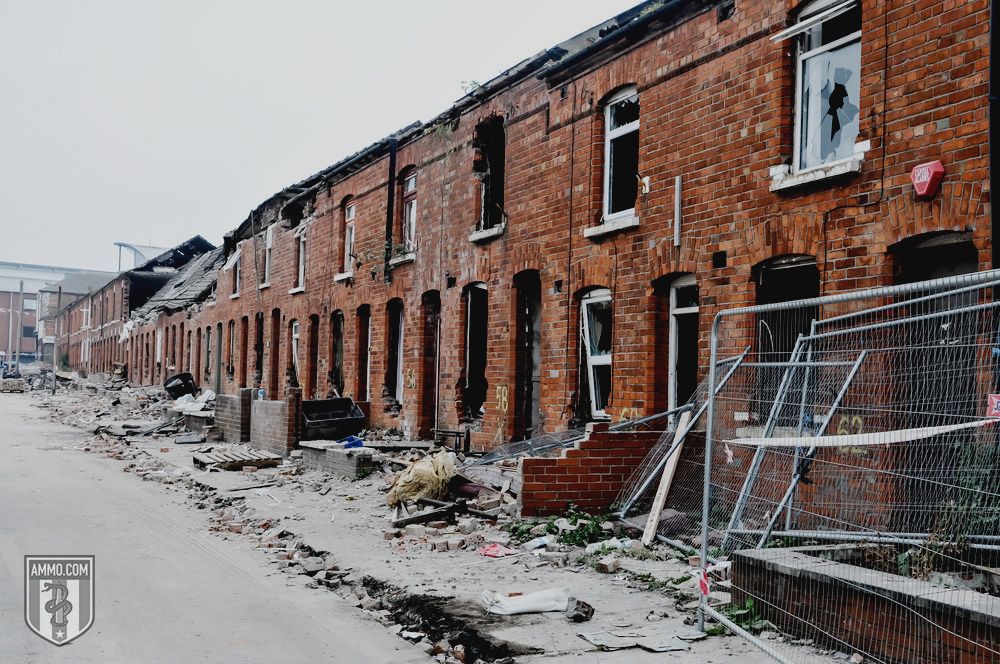The dust has settled and the evidence is in: The 1960s Great Society and War on Poverty programs of President Lyndon Baines Johnson (LBJ) have been a colossal and giant failure. One might make the argument that social welfare programs are the moral path for a modern government.
They cannot, however, make the argument that these are in any way effective at alleviating poverty.
“We waged a war on poverty and poverty won.”

This is not a moral or even a value judgment against the people engaged in such a culture. Again, the claim is not that people “choose to be on welfare,” but simply that social welfare programs incentivize poverty, which has an impact on communities that has nothing to do with individual intent.
We are now over 50 years into the development of the Great Society and the War on Poverty. It is time to take stock in these programs from an objective and evidence-based perspective. When one does that, it is not only clear that the programs have been a failure, but also that they have disproportionately impacted the black community in the United States. The current state of dysfunction in the black community (astronomically high crime rates, very low rates of home ownership and single motherhood as the norm) are not the natural state of the black community in the United States, but closely tied to the role that social welfare programs play. Or as Dr. Thomas Sowell stated:
“If we wanted to be serious about evidence, we might compare where blacks stood a hundred years after the end of slavery with where they stood after 30 years of the liberal welfare state. In other words, we could compare hard evidence on “the legacy of slavery” with hard evidence on the legacy of liberals.”
Here’s a peek into how black America has been a victim of LBJ’s Great Society and War on Poverty.
Defining Terms: What Is the Great Society and the War on Poverty?
Before going further, we must define the terms “Great Society” and “War on Poverty.” These are two overlapping, but somewhat distinct terms that are, in any event, not the same as “welfare” as a whole.
The “War on Poverty” refers to one part of the Great Society, namely the part focused specifically on poverty. When the War on Poverty was started in 1964, the poverty rate in America was 19 percent. Seeing an opportunity to recreate the same New Deal magic that had propelled President Franklin Delano Roosevelt to the White House in four successive elections 30 years earlier, Johnson pushed his War on Poverty.
It’s worth noting that the New Deal has some success to boast in terms of lifting some extremely poor communities, particularly those in the rural South, out of grinding forms of poverty. This was through, for example, mass electrification and other similar campaigns, which radically redefined the experience of the poor in the United States. One can argue about the ethics of redistributive wealth programs, but one cannot argue about whether or not, for example, the electrification of the Tennessee Valley elevated people out of crushing and abject poverty – it did.
There are four primary initiatives of the War on Poverty:
- The Economic Opportunity Act: This was the flagship effort of the War on Poverty. It created the Community Action Program, Volunteers in Service to America (VISTA) and Job Corps.
- The Food Stamp Act of 1964: This created a food stamp program that remained largely in place until President Bill Clinton “ended welfare as we know it.” At this time, food stamps were open-ended and could, in theory, be a means of feeding a family for life.
- Elementary and Secondary Education Act of 1964: This is known as the most sweeping legislation impacting education passed by the United States Congress. It sought to level an alleged “achievement gap” in public education. It has been reauthorized by both Democratic and Republican presidents under the names Improving America’s Schools Act of 1994, No Child Left Behind Act of 2004, and the Every Student Succeeds Act of 2015.
- Social Security Act of 1965: Created both Medicare and Medicaid.
The Economic Opportunity Act, in particular, was insidious in that it gave broad leeway to create programs without Congressional approval or oversight. An example of this is the Head Start program, which is shown to have only extremely limited and short-term effects on the ability of children to succeed in public schools.
The Great Society refers to a far broader set of programs, some of which still exist today, others of which were casualties of both the massive budget for the Vietnam War, LBJ’s other pet project, as well as the passage of time and subsequent Republican administrations. It’s difficult to summarize the Great Society as a whole, precisely because its scope was so broad. Education, health, welfare, culture (the Corporation for Public Broadcasting, for example, is a product of the Great Society), transportation, the environment, housing, labor and rural development were all areas where the Great Society had some hand.
Whereas the New Deal has demonstrably impacted communities with crushing and severe forms of poverty, the Great Society has demonstrably not only not “worked” by any available metric, it has also created a negative impact, most severely felt in the black community in the United States.
This article will make the case that the Great Society is the greatest disaster to befall America’s black community since slavery.
What Were the Goals of the Great Society?
Some discussion of the goals of the Great Society and its historical context are in order. The Great Society was seen by LBJ as nothing less than the completion of the New Deal as pioneered by his predecessor and mentor, Franklin Delano Roosevelt.

One of the glaring and immediate differences between the New Deal (where it was successful) and the Great Society was the definition of poverty. Poverty, the kind the New Deal was effective at reducing, was largely an objective condition. For example, people without electricity or running water in their homes. For the Great Society programs, however, poverty was largely defined in subjective, albeit quantifiable, terms like educational attainment and income level.
Here’s the problem with defining poverty in those terms: We now live in a world where the overwhelming majority of people who wish to get one can obtain a college degree. All this has done is devalue the college degree and saddle people with both unmarketable skill sets and a high level of nondischargeable debt. A college degree simply doesn’t mean much anymore because anyone who wants one can have one.
Similarly, consider income in real terms – the ability to buy things. The poorest people in America now have access to more computing power in their pocket than NASA used to go to the moon. Cheap consumer goods are plentiful, even for people with very low incomes – part-time minimum wage jobs, for example.
Poverty, defined as “making much less than rich people” or even “struggling to get by” simply means one is at the bottom of the economic ladder. The bottom of the economic ladder will always exist as long as there is one. Grinding, Third-World-style poverty – in the vast overwhelming majority of cases – is a thing of the past. The United Nations puts the percentage of Americans with access to electricity at 100.
A report estimated that 1.6 million Americans lack access to “clean” water, “clean” here being a weasel word that is undefined. Even if we took the 1.6 million figure at face value (which we should not), this means that approximately 0.48 percent of all Americans (i.e., less than half of one percent) do not have access to “clean” water.
In the absence of significant poverty conditions to attack, the “War on Poverty” was largely about hitting a moving target subjectively defined as “having less than some other people.”
Despite the best intentions (to which, it should be noted, “the road to hell is paved with”), the Great Society was bound to fail simply because there were no clear targets. In this sense, the War on Poverty prefigured other government wars on abstract concepts, such as the War on Drugs and the War on Terror.
The failure, of course, is seen by big government advocates as a sign that not enough has been done. Since the War on Poverty began, $15 trillion has been spent, with negligible impact on lifting people out of poverty. For context, the Apollo program cost $25.4 billion, $146.1 billion in 2019 dollars. Put simply, for the cost of the War on Poverty, America could have funded almost seven Apollo programs.
Unlike the War on Poverty, the Apollo program was a resounding and verifiable success.
The Breakdown of the Black Family
“The black family, which had survived centuries of slavery and discrimination, began rapidly disintegrating in the liberal welfare state that subsidized unwed pregnancy and changed welfare from an emergency rescue to a way of life.”
The biggest problem resulting from the Great Society is the breakdown of the black family. This is a sensitive subject, but one that must be broached to fully understand the devastating impact that the Great Society has had on the black community in the United States.
In 1965, when the Great Society began in earnest following the massive electoral landslide reelection of LBJ, the out-of-wedlock birthrate among the black community was 21 percent. By 2017, this figure had risen to a whopping 77 percent. In some cities, this rate is as high as 80 percent, with most of the unwed mothers being teenagers. We have documented extensively in our article on the death of civil society in the United States the negative effects of the single-parent household on child development and outcomes. The black community is now entering its third generation of single parenthood as the norm, something that rose astronomically with the advent of the Great Society.
To provide some historical context, the out-of-wedlock birth rate in the black community was already rising before the Great Society. In 1938, that rate stood at 11 percent. Still, it’s worth noting the difference between the slow and steady increase of 1938 to 1965, and the explosive growth from 1965 until the present day. In any event, black women were more likely to be married than white women as late as 1950. It’s also worth looking at single parenthood over time: In the 1950s, 52 percent of all black children lived with both parents until the age of 17. By the 1980s, that number had plummeted to 6 percent.
In addition to outcomes, there is also a wide divide between the percentage of black families in poverty when there is a father present. Among married black families, the poverty rate is 8 percent. Among black households headed by a single mother, that rate jumps to 37 percent.
And again, while we outline a number of negative consequences resulting from single-parent families, it’s worth pulling one out in relation to the destruction of the black family in America: There is no better predictor of male criminality than being raised in a fatherless home. 70 percent of all juvenile offenders in state reform institutions were raised in fatherless homes. This includes 60 percent of all rapists, 72 percent of all murderers, and 70 percent of long-term inmates.
Black Participation in the Labor Market
There is another statistic that is significant when it comes to evaluating the role of the Great Society in the destruction of the black family and, by extension, black society: participation in the labor market.
This is an important metric for a very simple reason: Few would argue that it’s better to not work than to work. Data provided by every census between 1890 and 1954 shows that black Americans were just as active – and sometimes more – in the labor market than their white counterparts. In 1900, for example, black unemployment was 15 percent lower than white unemployment. In 2017, it was 30 percent higher.
If the conventional narrative on black American poverty and general social dysfunction were correct – that this was caused by the legacy of slavery, Jim Crow, and private discrimination – wouldn’t we expect to see a decline in black unemployment rather than the opposite?
Black Business Ownership

There was also a social aspect to this period of black entrepreneurship. Black insurance companies and black-owned banks represent the apex of the economic pyramid in the black community. While the black community was comparatively poorer than its white counterparts, money spent by black Americans could stay within the black community. Thus, the black community could enrich itself from the bottom of the ladder all the way up to the top.
This concept was known as “double duty dollars.” The idea is that money spent at black businesses not only purchased goods for the consumer, but also played a role in advancing the black race in America. This, and not government handouts, was seen as the primary means of achieving, if not a perfect equality with whites, a social parity with them.
Another aspect of why black entrepreneurship was so important in the black community was that national businesses tended to ignore the black market entirely. This, however, began to change in the 1950s and, to a much greater extent, by the dawn of the next decade. No one forced national businesses to begin marketing their products to black America. National businesses simply saw that there was an emerging black middle class with money to spend and didn’t want to get cut out of the market.
Today, black business ownership is in a state of “collapse” according to Marketplace.org. This cannot entirely be laid at the foot of the Great Society. For example, the unlikely culprit of integration is one of the reasons that the black business districts began to fall apart. For example, once the biggest burger joint in town would serve black people, there was no reason to go to “the black burger joint” anymore.
Still, it’s impossible to separate the end of the thriving black business districts from the Great Society. These were once centers of the community, in addition to being centers of commerce. Now they are virtually extinct. While other factors are in play, it’s difficult to not notice the overlap between the rise of the welfare state through the Great Society, the overall decline in the black community’s civil society anchored by the black business community, and black business ownership in general.
The Decline in Black Homeownership
Another area where the impact of Great Society policies is seen is in statistics on black homeownership. The black homeownership rate is basically the same today as it was 50 years ago. There was a spike in black homeownership during the Bush years. However, these were largely a function of subprime mortgages being given out to people who couldn’t really afford them.
Few places saw the hand of government on the scale more than housing. One of the final policy initiatives of the Great Society was the Fair Housing Act, which banned discrimination in housing sales (but not in lending practices). This effectively meant an end to “restrictive covenants,” which allowed a homeowner to specify that their house could not be sold to a black family, not just for an individual sale, but in perpetuity.
As a brief aside, this is, as are many other parts of the Great Society, an egregious attack on freedom of association, property rights, and ability to transact and dispose of one’s property in a manner of one’s own choosing.
Which Way Forward for the Black Community
It’s difficult to ignore that black Americans vote overwhelmingly for the Democratic Party, who champion the policies of the Great Society, which have largely destroyed the black family and black civil society. Why is this?

The flip side of this is that there is not much incentive on the part of Republicans to court black voters. While the Nixon “Southern Strategy” is slightly distorted when presented, the core of this narrative is true – when presented with various strategies for victory, Nixon chose to appeal to northern, union Catholic workers and Southern Protestant conservatives, both of whom were white. This is simple math: A large increase in the black vote doesn’t represent a whole lot of votes, but a minor increase in the white vote moves the needle significantly. The so-called “Sailer strategy,” named after Steve Sailer, exploits this math: Spiking the rural white vote to record levels while effectively ignoring all other voting blocs is what delivered Donald Trump the presidency.
The point here is that neither party is incentivized to offer solutions to black Americans. But black Americans are also not demanding solutions from either political party, as evidenced by the lockstep voting for Democratic Party politicians, despite failing to deliver anything of value in 50 years.
One historical example that might represent a way forward is the National Black Independent Political Party. Formed in 1988, it had virtually no impact on electoral politics. However, its model might represent something of value for black Americans looking to break free of the two-party duopoly and demand actual policy solutions from Washington. The purpose of the NBIPP was not to obtain power in its own right, but rather to form black America into a political voting bloc that could act as kingmaker in elections. This is in the broader tradition of self-reliance in the black community.
Whatever the way forward is, one thing is clear: Social welfare programs ostensibly designed to help the black community have done little more than put the boot of government on the neck of black Americans. Rather than raising up the black community, these programs have acted to – despite whatever their intentions might be – destroy the black family, the black business community, and black social solidarity.
What might “work” depends on what the goal is. However, the evidence is in and the Great Society’s War on Poverty has been a resounding failure.
Black America Before LBJ: How the Welfare State Inadvertently Helped Ruin Black Communities originally appeared in the Resistance Library at Ammo.com.































